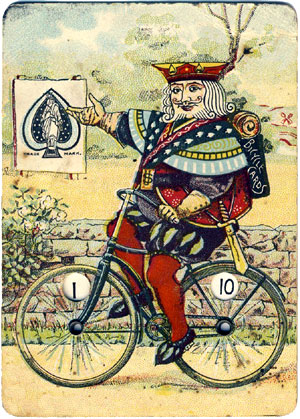Bicycle No.808
The famous Bicycle playing cards were first introduced by Russell & Morgan Printing Co in 1885. More recently the brand has been open to private designers since the early 2000s.
The Russell & Morgan Printing Co • The United States Playing Card Company
Right: an advertising card counter that was distributed to promote the 'Bicycle' brand →
The famous ‘Bicycle’ playing cards were first introduced by Russell & Morgan Printing Co in 1885. This was the time of the high-wheeled bicycles and, because they were newer and faster than high-wheeled carts, the name ‘Bicycle’ was chosen for the new brand. They were hugely successful and became the most well-known brand in the world. A total of 82 different back designs were issued over the years, featuring bicycles, motorcycles or automobile motifs, and for very short periods, bi-planes or warships. Similarly, a number of different bicycle-themed Jokers have accompanied decks over the years and the early editions are now very scarce and sought by collectors.

Above: the first edition of Bicycle playing cards, including a “Best Bower” and issued with seven different back designs of which Lotus, the one shown here, was one. Printed by Russell & Morgan Printing Co., Cincinnati, 1885. See the Box. Image courtesy Rod Starling.
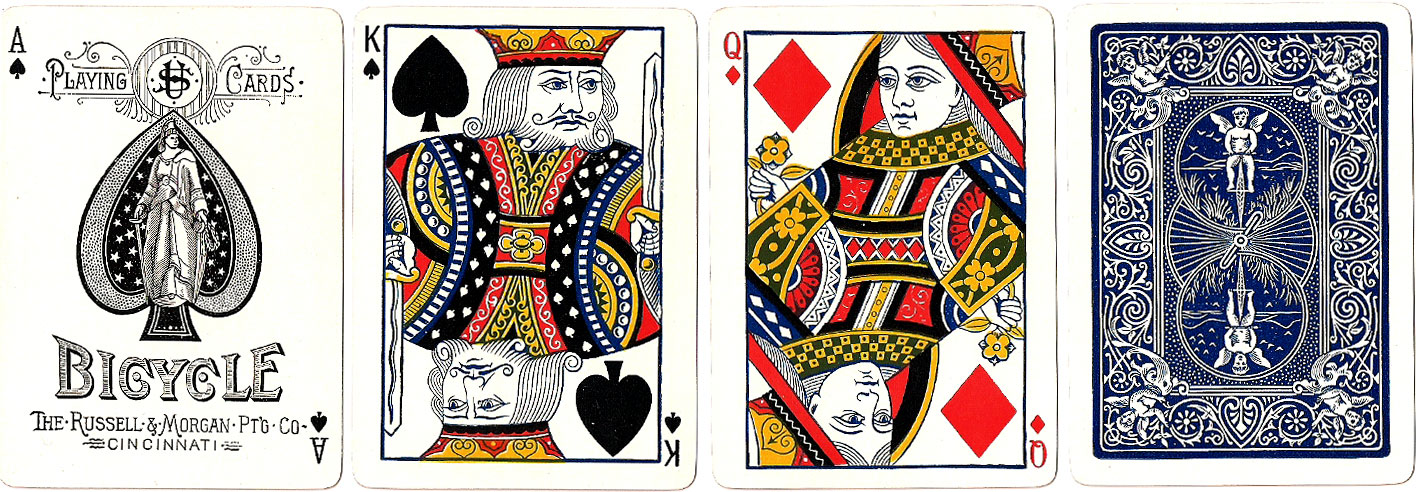
Above: the first Ace of Spades was used with Bicycle decks, printed by Russell & Morgan Printing Co., between 1885-c.1890. The same box was used for this edition and the one shown below. Images courtesy Rod Starling.
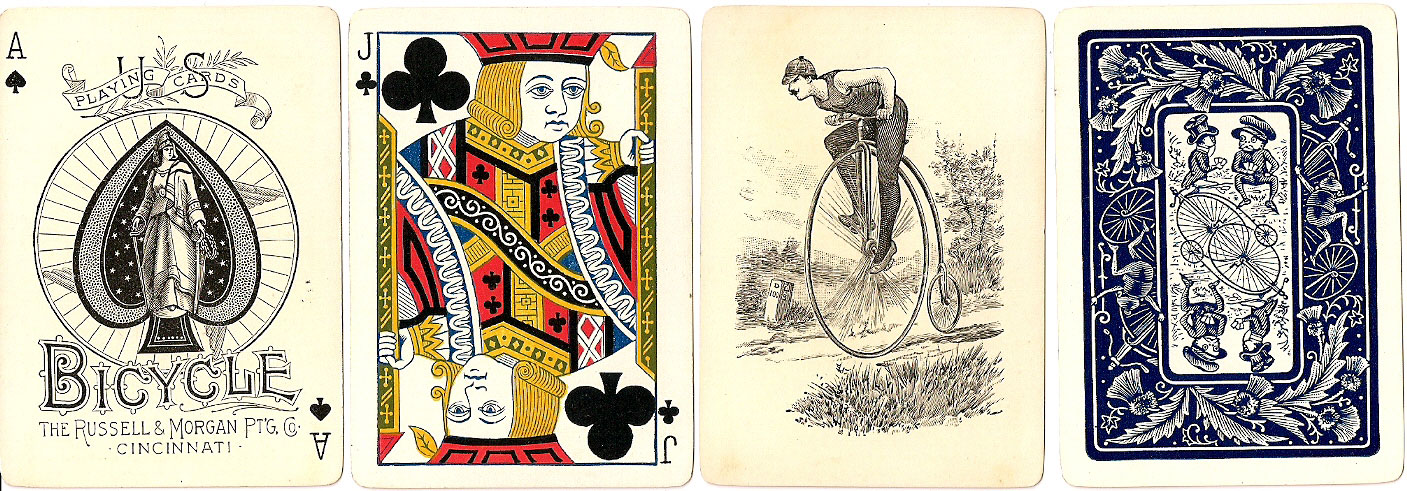
Above: this is the second Ace of Spades used with Bicycle decks, printed by Russell & Morgan Printing Co. c.1889. It has a bicycle wheel motif on the Ace, with the very early and rare Hi Wheeled Joker, as shown, with a Thistle back design and is gold edged. Thistle was issued in red and blue. This particular Thistle design was issued in 1891 and features a grass background. In 1899, the design was changed slightly to include a brick background. It was eventually discontinued in 1931. Note that neither the customary 'US' or 'Joker' inscriptions are present on the Joker. Subsequent editions came with different Jokers. Image courtesy Rod Starling.
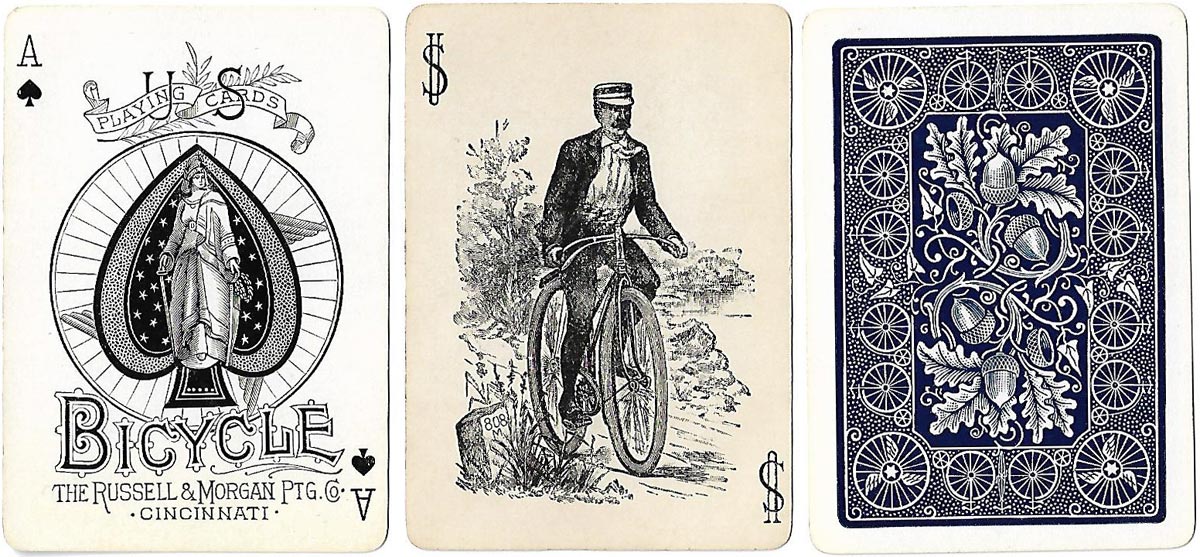
Above: another early and rarer Lo-Wheel Joker and an Acorn back design which was issued in 1891 and discontinued in 1943. Acorn was issued in red, blue, brown and green. Image courtesy Rod Starling.
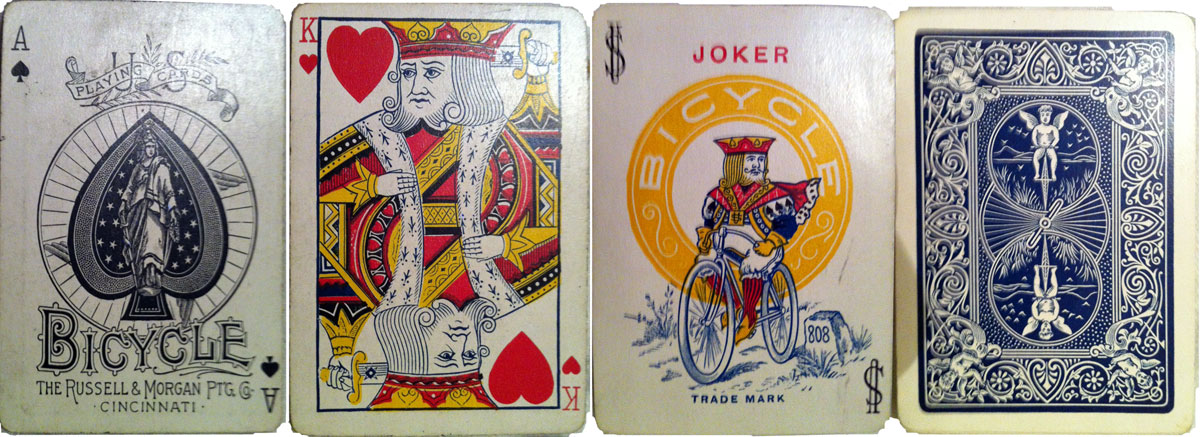
Above: as above, but with the rarer coloured Joker, c.1894. The box states ‘Bicycle Seconds’. Image courtesy Jesse Hobbs.
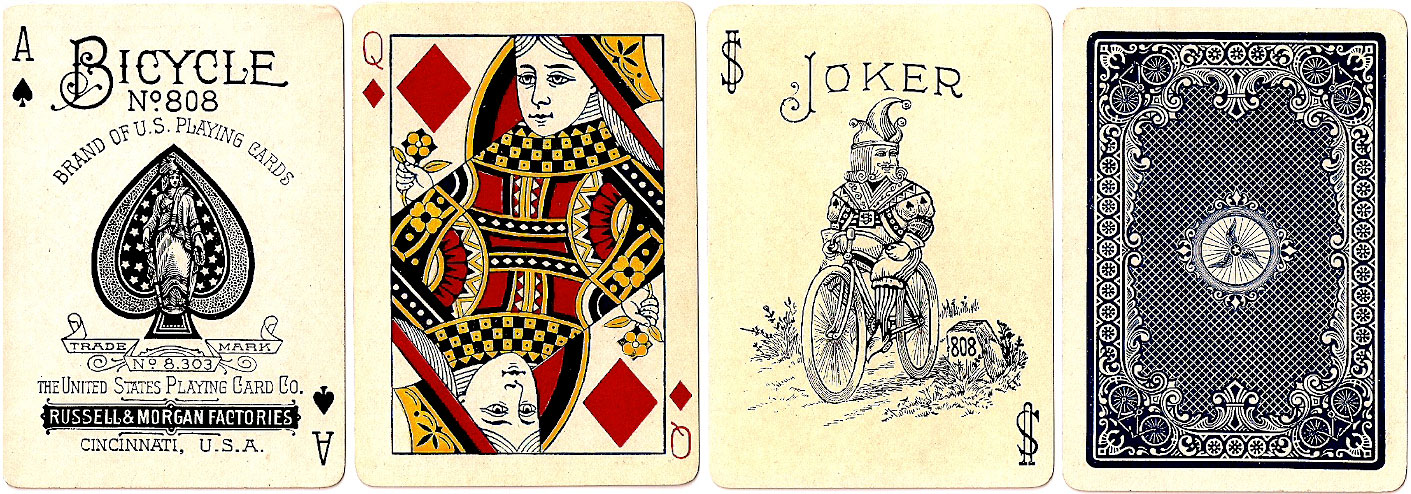
Above: Bicycle #808 deck printed by U.S.P.C. Co., at their Russell & Morgan factories, c.1895. The court cards have a slightly different design, as can be seen from the Queen of Diamonds. The back design is Racer No.1 which ran from 1895 to 1906. The Joker features a King wearing a Jester's hat, riding a bicycle past an '808' milestone. Click here to view the box. Image courtesy Rod Starling.
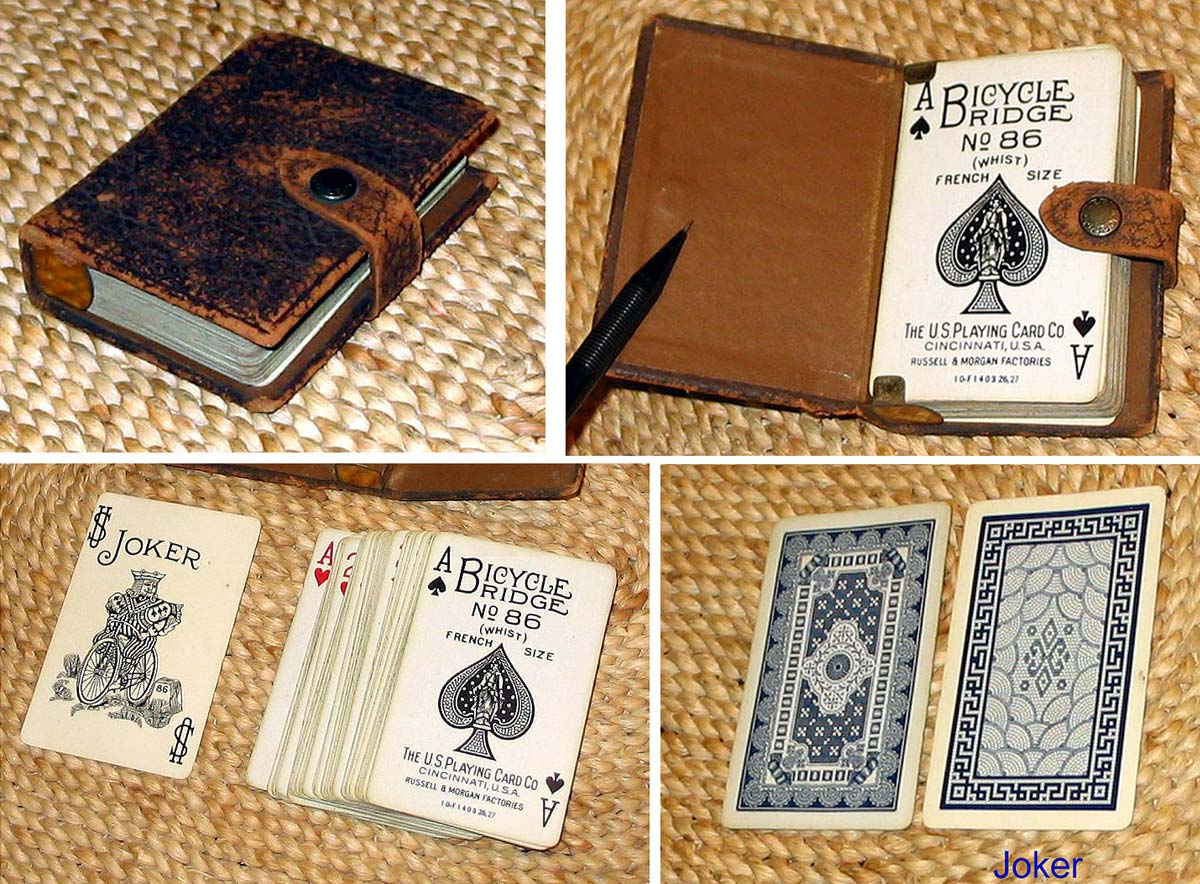
Above: Bicycle Bridge No.86 printed by U.S.P.C. Co. at their Russell & Morgan factories, c.1920. The deck is in the narrower French (Whist) size (2¼ x 3½ inches) and the first of a series of narrow decks produced by USPCC under their Bicycle brand. 52 cards + joker. Note that the joker has the number ‘86’ on the milestone but has a different back design in this example! Images courtesy Gino Hasler.

Above: A Braille 'Bicycle No.808' deck for the blind with the card indices embossed in Braille on each card, c.1924. 54 cards. Each card is embossed with its Braille representation of value and suit, including the two jokers. Unfortunately, the embossing goes right through the cards so that a sighted person can read the back of each card like any other marked pack. This is the more common of the early 'Bicycle' Aces of Spades and was used until at least 1925. The Joker depicts a 'King' riding a bicycle past an 808 milestone, similar to the trade card shown above.
Most standard packs manufactured by USPCC came with either red or blue backs. Some brands also came in green or brown, but these are relatively more scarce.
The Bicycle Playing Cards official website contains a lot of interesting information, including company history and a downloadable catalogue. See also: Bicycle Playing Cards for Collectors • Bicycle Seconds • Congress No.606 • Jumbo Bridge No.88 • Norwood #85
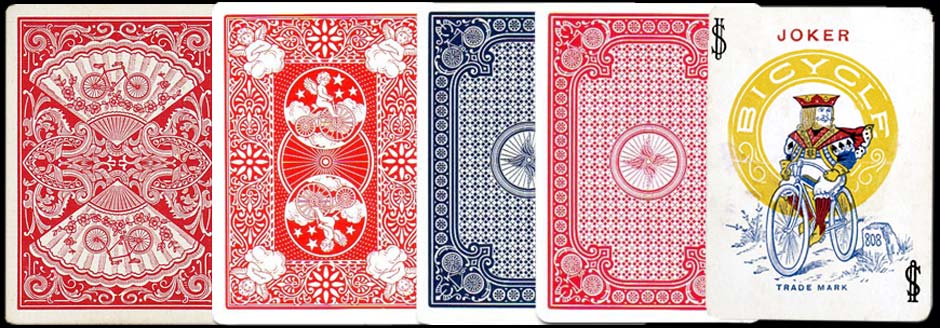
Above: assorted backs from 'Bicycle' playing cards, from a total of over 80 different designs, and a multi-coloured Joker. more →
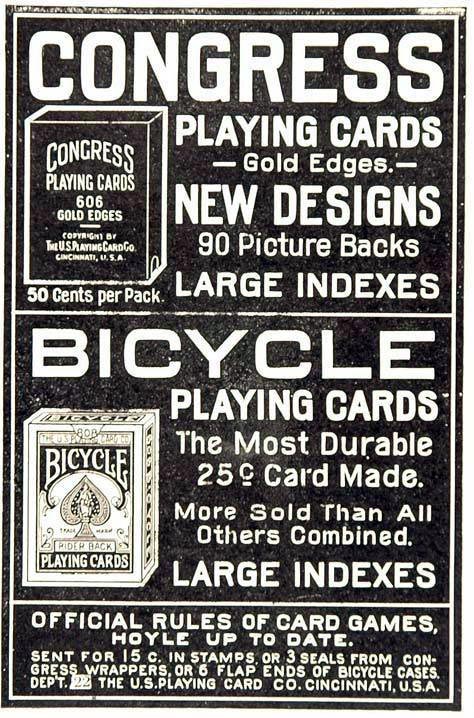
References:
Dawson, Tom & Judy: The Hochman Encyclopedia of American Playing Cards, U.S. Games Systems Inc., 2000
Hargrave, Catherine Perry: A History of Playing Cards and a Bibliography of Cards and Gaming, Dover Publications, New York, 1966


By Simon Wintle
Member since February 01, 1996
I am the founder of The World of Playing Cards (est. 1996), a website dedicated to the history, artistry and cultural significance of playing cards and tarot. Over the years I have researched various areas of the subject, acquired and traded collections and contributed as a committee member of the IPCS and graphics editor of The Playing-Card journal. Having lived in Chile, England, Wales, and now Spain, these experiences have shaped my work and passion for playing cards. Amongst my achievements is producing a limited-edition replica of a 17th-century English pack using woodblocks and stencils—a labour of love. Today, the World of Playing Cards is a global collaborative project, with my son Adam serving as the technical driving force behind its development. His innovative efforts have helped shape the site into the thriving hub it is today. You are warmly invited to become a contributor and share your enthusiasm.
Related Articles

Rap Rummy
Rap Rummy made by Parker Brothers in 1926, only 4 years after the discovery of King Tutankhamen’s to...

German Travel Cards
A travel-themed educational deck helping American tourists visiting Germany.

Can You Believe Your Eyes?
“Can You Believe Your Eyes?” playing cards featuring visual illusions & other oddities.

Get Decked
Black and white cartoons devised by Sam Wagner with help from artist Lindsay Bevington.

Beowulf
Jackson Robinson's Beowulf playing card deck inspired by the Old English pagan poem.

Keith Haring playing cards
Energetic graffiti images by the American artist Keith Haring.

The Tarot of Meditation – Yeager Tarot
Marty Yeager’s original Tarot of Meditation from 1975, republished later by U.S. Games Systems, Inc....

Adobe Deck
The first digitally-produced deck of cards.

Seminole Wars deck
Seminole Wars deck by J. Y. Humphreys, Philadelphia, c.1819.

The UCR Deck
Giant-size cards designed by Thomas Sanders to advertise courses and facilities at UCR.

Fredericks & Mae playing cards
A rainbow pack from the design team of Fredericks & Mae and Benjamin English.

Red Hat Society playing cards
Society that encourages women in their quest to get the most out of life.

Mountain Dream Tarot
Groundbreaking Tarot created by Bea Nettles, using photographs and photo montage.

Junior Playing Cards
Child-friendly versions of standard English pattern cards designed by Louie Mantia, Jr.

Last Call Cats playing cards
Bar-crawling cats, designed by artists Arna Miller and Ravi Zupa.

Covered bridges playing cards
Historical covered bridges with photography by Bill Miller, 2006.
Most Popular
Our top articles from the past 28 days


